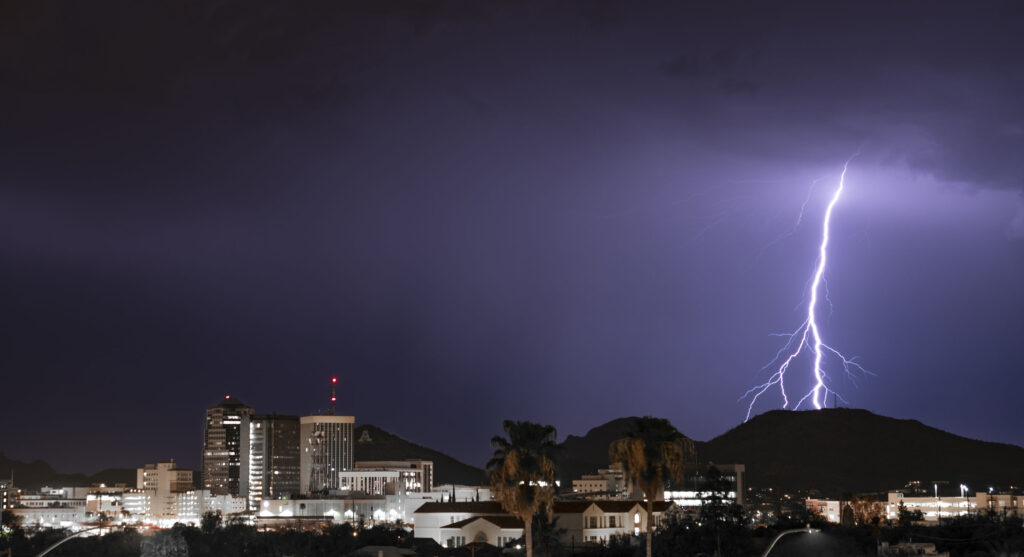
Arizona monsoon season starts in June and stretches all the way through September. It can bring pounding rain, lightning, dust storms, harsh winds, punishing heat, flash floods, and a considerable increase in humidity. These conditions are both uncomfortable and dangerous. An excess of automotive oil and other fluids can also emerge from the pavement when monsoon showers arrive, increasing your chances of a summer car accident.
If you suffer an injury because of the reckless act of another while driving during monsoon season, our Phoenix personal injury attorney will help you pursue your due compensation. You can do your part to avoid an accident by following these Arizona monsoon season driving tips.
Reduce Your Speed
Though Arizona monsoon season does not bring powerful rainstorms every single day, the summer rain is especially harsh when the skies open up. If you are caught in a nasty rainstorm or dust storm, do not attempt to travel at or above the speed limit.
Reduce your speed to a rate that permits visibility and sufficient control, decreasing your chances of a car accident. There is no harm in pulling over to the side of the road and waiting out the storm. Just be sure to move completely off the road so other drivers do not slam into your vehicle.
Preparation Is Essential
Prepare for monsoon season well ahead of time. Put bottled water, non-perishable food, an emergency medical kit, rain jacket, and an umbrella in your vehicle. Switch out old windshield wipers with new ones so your vehicle is ready to handle the downpour.
Though the threat of a light or moderate rainstorm should not stop you from heading out, you should still check the weather before leaving home, work, or elsewhere. If the weather forecast predicts a torrential downpour, flash flooding, dust storms, or excessive lightning, consider delaying or canceling your plans.
Respect the Danger Posed by Flash Flooding
A flash flood has the potential to take your life. Flash flooding can put an entire neighborhood, street, or other space under a significant amount of water. Try to stay far away from washes, rivers, and other areas with water during flash floods.
If you spot a flooded area ahead, do not hesitate to turn around or pull over and use your smartphone or GPS to look up another route. When in doubt, err on the side of safety. It takes merely a few inches of moving water to carry a vehicle in a wayward manner. Your best option is to either stay at home or head to higher ground to avoid potential flash flooding.
Dust Storms
Arizona monsoon season can generate breathtaking yet hazardous dust storms. These walls of dust can stand upwards of a mile high. Though dust storms look amazing from a distance, they are treacherous to everyone in their vicinity as they can roll across a large stretch of terrain and shift daylight into complete darkness.
Dust storms that are not particularly harsh are still a threat as they are almost always sandwiched between monsoon rainstorms. If you spot a dust storm ahead, consider reversing or altering your course to travel far away from the storm. The last thing you want is to be trapped in a dust storm that makes it impossible to see the road ahead.
Arizona Monsoon Season Also Brings Lightning
The Grand Canyon State’s lightning storms are not as fierce as those in the Midwest, yet they are frequent in number. The National Weather Service reports 1.5-million lightning strikes occur in Arizona and New Mexico each year.
Take the proper precautions and you will not become a statistic. Most people are surprised to learn 49 people in the United States perish from lightning strikes each year. Furthermore, hundreds suffer painful injuries like electric shock or burn injuries resulting from lightning strikes in the United States alone.
If a storm approaches, find shelter. As long as there is not a threat of flooding, look for a structure on low ground with plumbing fixtures so you can remain comfortable while waiting for the storm to end.
Alternatively, you can remain in your vehicle as long as it has a metal roof. If you hear thunder, remain alert. The sound of thunder indicates you are within range of lightning. Stay away from trees, rocky cliffs, water, and metal objects as you seek safety at a low elevation.
Do Not Cross Flooded Washes
There is no sense attempting to cross a flooded wash. It does not matter if the wash looks shallow; an attempt to cross such a flooded space could prove deadly. Respect the power of water. It takes merely a couple inches of fast-moving water to put your personal safety and your vehicle in jeopardy.
Remain Alert at All Times
Arizona has its fair share of mountains, cliffs, boulders, and rocks. Heavy rain, wind, and storm runoff loosens rocks and even some boulders. It is possible loose rocks and boulders may slide down highway slopes. Remain alert when driving on the highway and other areas near such slopes. A quick reaction to dodge a large rock or boulder just might prevent an accident and save your life.
Injured on the Road or Highway During Arizona Monsoon Season?
If you are injured in any way when traversing Arizona’s roads or highways in Scottsdale, Glendale, Tolleson, Gilbert, or a surrounding city, our Phoenix personal injury attorney can help.
Reach out to us today at 602-977-1900 to schedule an initial consultation. Our office hours are 8:00 a.m. to 5:00 p.m., Monday through Friday. We will take your call anytime, 24/7. You can even contact us online by taking advantage of our LiveChat feature.



